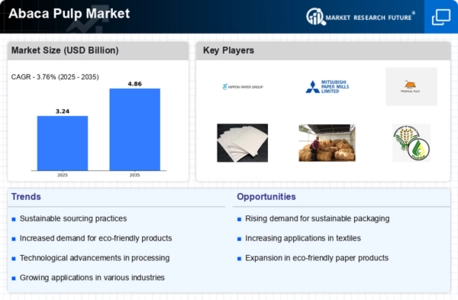Technological Innovations
Technological advancements are playing a crucial role in the evolution of the Abaca Pulp Market. Innovations in processing techniques and machinery have improved the efficiency and quality of abaca pulp production. For instance, the introduction of advanced pulping technologies has reduced production costs and enhanced the fiber's properties, making it more competitive against synthetic alternatives. This trend suggests that manufacturers are likely to invest in research and development to further optimize production processes. Additionally, the integration of automation in the production line may lead to increased output and reduced labor costs, thereby positioning the abaca pulp market favorably in the broader pulp and paper industry.
Rising Demand in Packaging
The Abaca Pulp Market is witnessing a surge in demand for sustainable packaging solutions. As industries seek alternatives to plastic, abaca pulp is emerging as a viable option due to its strength and biodegradability. The packaging sector, which is projected to account for a significant share of the abaca pulp market, is increasingly adopting natural fibers to meet regulatory requirements and consumer preferences for eco-friendly products. This shift is likely to drive market growth, with estimates suggesting that the packaging segment could represent over 30 percent of the total abaca pulp market by 2030. The versatility of abaca pulp in producing various packaging materials, such as bags and containers, further enhances its market potential.
Sustainability Initiatives
The Abaca Pulp Market is experiencing a notable shift towards sustainability initiatives. As consumers increasingly prioritize eco-friendly products, the demand for abaca pulp, known for its biodegradability and low environmental impact, is likely to rise. This natural fiber, derived from the banana plant, is not only renewable but also contributes to sustainable agricultural practices. The industry appears to be aligning with global sustainability goals, which may enhance its appeal among environmentally conscious consumers. Furthermore, the abaca pulp market is projected to grow at a compound annual growth rate of approximately 5.2 percent over the next five years, driven by the increasing adoption of sustainable materials in various sectors, including packaging and textiles.
Growth in Textile Applications
The Abaca Pulp Market is also benefiting from the expanding applications in the textile sector. Abaca fibers are known for their durability and unique texture, making them suitable for a range of textile products, including clothing and home furnishings. The increasing consumer interest in sustainable fashion is likely to propel the demand for abaca pulp, as brands seek to incorporate natural fibers into their collections. Market analysts indicate that the textile segment could experience a growth rate of approximately 4.5 percent annually, driven by the rising trend of eco-conscious consumerism. This growth may further solidify the position of abaca pulp as a key player in the sustainable textiles market.
Government Support and Policies
Government support and favorable policies are emerging as significant drivers for the Abaca Pulp Market. Various countries are implementing regulations that promote the use of sustainable materials, which could enhance the market for abaca pulp. Initiatives aimed at supporting local farmers and promoting the cultivation of abaca plants are likely to increase production capacity and improve supply chain dynamics. Furthermore, subsidies and incentives for sustainable agricultural practices may encourage more farmers to engage in abaca cultivation, thereby boosting the availability of raw materials for the pulp industry. This supportive regulatory environment could potentially lead to a more robust and resilient abaca pulp market in the coming years.



.webp)
.webp)
.webp)
.webp)
.webp)
.webp)








Leave a Comment